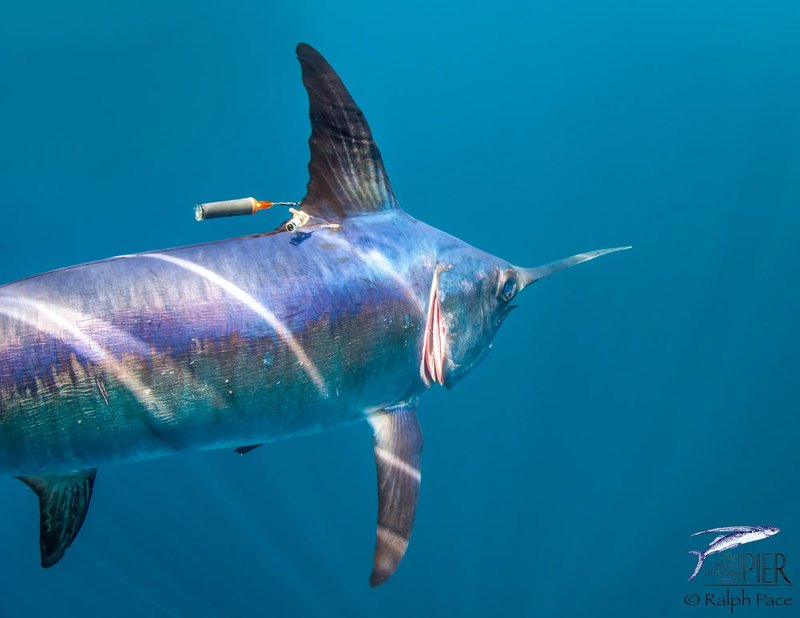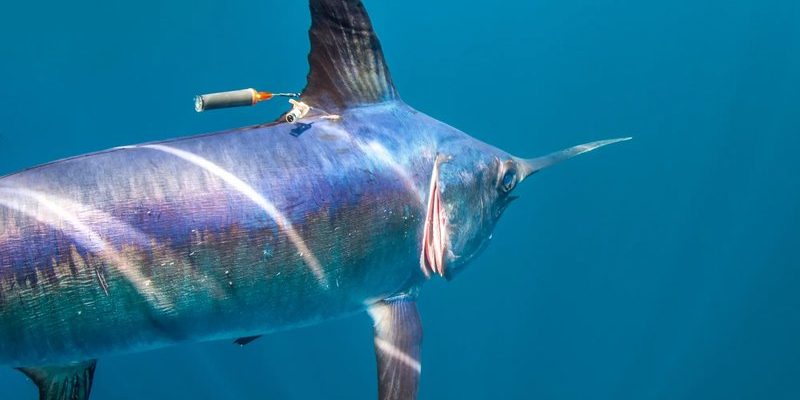
These adaptations are crucial for survival, allowing swordfish to hunt efficiently, escape predators, and thrive in different temperatures and depths. Imagine wearing specialized gear that helps you breathe or see better—these adaptations serve a similar purpose for the swordfish. Let’s dive deeper into the amazing ways this remarkable fish has evolved to succeed in its watery world.
1. Streamlined Body Shape for Speed
One of the first things you notice about the swordfish is its streamlined body, designed for speed. Think of it like a bullet cutting through the air; this shape allows swordfish to swim effortlessly through water. Their bodies are long and slender, reducing drag as they move. This adaptation is essential for both hunting prey and evading larger predators.
Additionally, swordfish have powerful muscles that give them bursts of speed. They can swim up to 60 miles per hour! That’s faster than most cars drive on a highway! This speed allows them to chase fast-moving prey like squids and various fish.
Moreover, their unique body shape means they can make quick turns and rapid movements, which is crucial when hunting or escaping danger. The combination of a sleek design and powerful muscles sets swordfish apart in the underwater world, making them one of the fastest fish around.
2. Specialized Bill for Hunting
The swordfish’s most striking feature is its long, pointed bill, which plays a vital role in its hunting strategy. You might think of it as a chef’s knife slicing through the kitchen—this bill is used to effectively slash at schools of fish, stunning them and making them easier to catch.
Here’s the thing: using their sword-like bill isn’t just about brute force. It’s also about strategy. Swordfish will swim through groups of fish, using their bill to poke and jab, which creates chaos among their prey, allowing them to capitalize on the confusion.
In addition, the bill can be a useful tool for defending against predators. Although swordfish don’t have many natural enemies due to their size and speed, larger sharks sometimes pose a threat. When faced with danger, a swordfish can use its bill to fend off attackers, making it a multi-functional tool in their survival kit.
3. Adaptable Vision for Low-Light Conditions
When you think about swimming in dark waters, you might feel a bit uneasy. But for swordfish, it’s just another part of life. They have evolved large, well-adapted eyes that are perfect for low-light conditions. This adaptation allows them to hunt effectively even in the depths of the ocean where sunlight barely reaches.
Swordfish have a special layer of tissue behind their retina called the tapetum lucidum. This reflective layer enhances their ability to see in dim light, similar to how cats can see well at night. With enhanced vision, swordfish can spot prey in murky waters, giving them a significant advantage during low-light hours, such as dawn or dusk.
Furthermore, their excellent vision allows them to navigate their environment more efficiently. It helps them avoid obstacles and detect potential dangers. So, while we might struggle to see clearly underwater, swordfish glide through the gloom with ease.
4. Thermoregulation for Temperature Control
You might be wondering how swordfish manage to thrive in both warm and cooler waters. The secret is in their ability to thermoregulate, or control their body temperature. Unlike most fish that are cold-blooded and rely on their environment, swordfish can maintain a body temperature that is warmer than the surrounding water.
This adaptation allows them to swim faster and be more active, especially in colder waters. By warming their muscles, they can maintain their impressive speed during hunts. Think of it like having a built-in heater that helps you stay warm on a chilly day; it gives them a competitive edge over their prey.
Additionally, being warmer helps their muscles perform better, contributing to their incredible agility. This adaptation allows the swordfish to inhabit various oceanic zones, from tropical to temperate waters, expanding their range and available food sources.
5. Camouflage and Counter-Shading
In the underwater world, being seen can be a deadly disadvantage. Swordfish use a strategy called counter-shading to blend into their surroundings. Their bodies are darker on the top and lighter on the bottom. This coloration helps them stay hidden from both prey and predators.
Imagine standing on the bottom of a pool and looking up at the sun. If you’re wearing darker clothes, you’re harder to spot from above. That’s how swordfish camouflage themselves from above while hunting. When looking down from above, they blend into the ocean depths, making it challenging for prey to notice them until it’s too late.
This clever adaptation acts like a built-in invisibility cloak, allowing them to ambush their prey more effectively. It helps swordfish become stealthy predators, relying on their speed and surprise to catch food.
6. Robust Immune System for Ocean Survival
Life in the ocean comes with its share of challenges, including diseases and parasites. Luckily, swordfish have a robust immune system that helps them stay healthy against these threats. Think of it like having a supercharged security system protecting your home from intruders; it’s essential for survival.
Their immune system is equipped to fight off various infections and adapt to different environmental stressors. This resilience is vital, especially as swordfish often travel long distances, exposing them to various pathogens.
Moreover, a healthy immune system means swordfish can maintain their vigor and agility, essential traits for a top predator. So, while they might not have visible armor, their internal defenses are impressive, ensuring they can thrive wherever they swim.
7. Social Behavior and Hunting Strategies
While swordfish are often solitary creatures, they do exhibit some interesting social behaviors during hunting. They sometimes gather in small groups to hunt, which can dramatically increase their success rate. You could think of it like a team of athletes working together to win a game; coordinated efforts yield better results.
When hunting in groups, swordfish can create distractions, making it easier for their teammates to snag a meal. They may take turns shocking and stunning prey, making it a more efficient operation.
This social hunting behavior also helps swordfish adapt to changing environments. By occasionally teaming up, they can explore new hunting grounds and share knowledge of where to find the best food sources, ensuring their survival in ever-changing ocean conditions.
In conclusion, the swordfish’s adaptations are a masterclass in survival. From their streamlined bodies and specialized bills to their impressive vision and thermoregulation, these features help them thrive in the harsh realities of the ocean. Next time you think about the ocean’s wonders, remember the swordfish and how its unique adaptations make it one of the most remarkable creatures of the sea. The mysteries of the underwater world are vast, but the swordfish offers a glimpse into the ingenuity of nature, reminding us how life persists in the most challenging environments.

